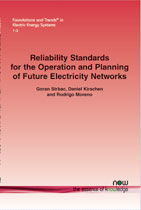Reliability Standards for the Operation and Planning of Future Electricity Networks
By Goran Strbac, Imperial College London, UK, g.strbac@imperial.ac.uk | Daniel Kirschen, University of Washington, USA, kirschen@uw.edu | Rodrigo Moreno, University of Chile, Chile, rmorenovieyra@ing.uchile.cl
Abstract
Electricity networks, designed and operated in accordance with the historic deterministic standards, have broadly delivered secure and reliable supplies to customers. A key issue regarding their evolution is how the operation and planning standards should evolve to make efficient use of the existing assets while taking advantage of emerging, non-network (or non-wires) technologies. Deployment of the smart grid will require fundamental changes in the historical principles used for network security in order to ensure that integration of low-carbon generation is undertaken as efficiently as possible through the use of new information and communication technology (ICT), and new flexible network technologies that can maximize utilization of existing electricity infrastructure. These new technologies could reduce network redundancy in providing security of supply by enabling the application of a range of advanced, technically effective, and economically efficient corrective (or post-fault) actions that can release latent network capacity of the existing system. In this context, this paper demonstrates that historical deterministic practices and standards, mostly developed in the 1950s, should be reviewed in order to take full advantage of new emerging technologies and facilitate transition to a smart grid paradigm. This paper also demonstrates that a probabilistic approach to developing future efficient operating and design strategies enabled by new technologies, will appropriately balance network investment against non-network solutions while truly recognizing effects of adverse weather, common-mode failures, high-impact low-probability events, changing market prices for pre- and post-contingency actions, equipment malfunctioning, etc. This clearly requires explicit consideration of the likelihood of various outages (beyond those considered in deterministic studies) and quantification of their impacts on alternative network operation and investment decisions, which cannot be undertaken in a deterministic, “one size fits all” framework. In this context, we developed advanced optimization models aimed at determining operational and design network decisions based on both deterministic and probabilistic security principles. The proposed models can recognize network constraints/congestion and various operational measures (enabled by new technologies) composed of preventive and corrective control actions such as operation of special protection schemes, demand side response and generation reserve utilization and commitment, considering potential outages of network and generation facilities. The probabilistic model proposed can also provide targeted levels of reliability and limit exposure to severe low probability events (mainly driven by natural hazards) through the use of Conditional Value at Risk (CVaR) constraints, delivering robust and resilient supplies to consumers at the minimum cost. Through various case studies conducted on the Great Britain (GB) power network, we set out the key questions that need to be addressed in support of the change in network reliability paradigm, provide an overview of the key modelling approaches proposed for assessing the risk profile of operation of future networks, propose a framework for a fundamental review of the existing network security standards, and set out challenges for assessing the reliability and economics of the operation of future electricity network.
Reliability Standards for the Operation and Planning of Future Electricity Networks
Reliability Standards for the Operation and Planning of Future Electricity Networks looks at why historical deterministic practices and standards, mostly developed in the 1950’s, should be reviewed in order to take full advantage of new emerging technologies and facilitate transition to a smart grid paradigm. It also demonstrates that a probabilistic approach to developing future efficient operating and design strategies enabled by new technologies, will appropriately balance network investment against non-network solutions while truly recognizing the effects of adverse weather, common mode failures, high impact low probability events, changing market prices for pre and post-contingency actions, equipment malfunctioning, etc. This clearly requires explicit consideration of the likelihood of various outages (beyond those considered in deterministic studies) and quantification of their impacts on alternative network operation and investment decisions, which cannot be undertaken in a deterministic, “one size fits all” framework.
Through various case studies conducted on the Great Britain (GB) power network, this monograph sets out the key questions that need to be addressed in support of change in the network reliability paradigm. It provides an overview of the key modelling approaches proposed for assessing the risk profile of operation of future networks, proposes a framework for a fundamental review of the existing network security standards, and sets out challenges for assessing the reliability and economics of the operation of future electricity networks.
